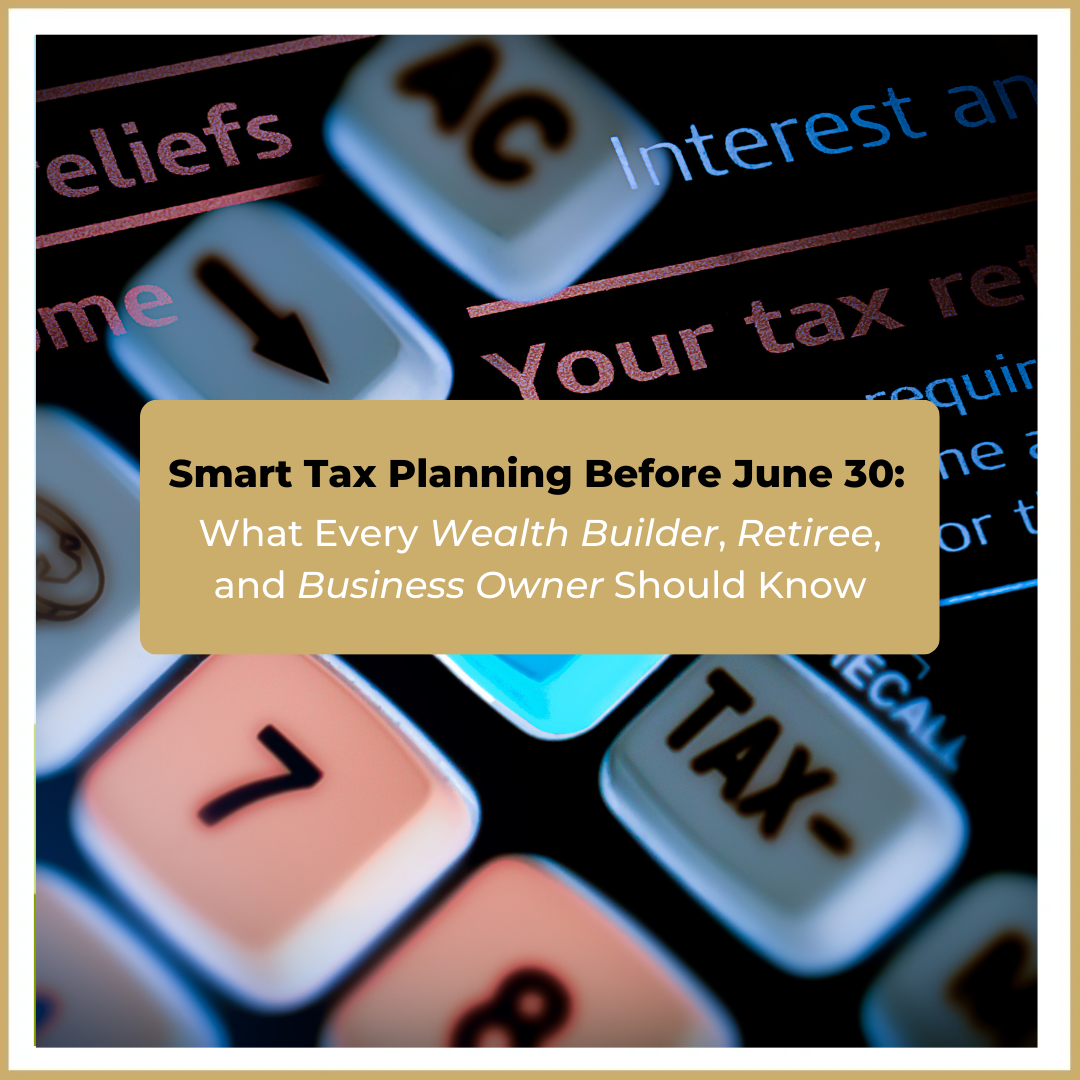As we approach the end of the financial year, the flood of EOFY sales, tax-saving tips, and rushed business purchases begins. While it’s tempting to scramble for last-minute deductions, it’s critical to step back and take a strategic view.
After all, not all deductions are created equal, and sometimes a deduction done poorly can cost more than it saves.
At CFV Services, we support three key client groups with tailored strategies: wealth builders (aged 25–45), pre-retirees/retirees (45–55+), and business owners. Each group has specific opportunities—and traps—when it comes to year-end tax planning.
In this guide, I’ll share a nuanced perspective on deductions: not just what you can do before June 30, but what you should do to build and preserve wealth.

💼 What Is a Tax Deduction? And Why Should You Be Cautious?
Let’s break this down clearly.
A tax deduction reduces your taxable income. For example, if you earn $100,000 and claim a $1,000 deduction, your taxable income drops to $99,000. If you’re in a 30% tax bracket, that deduction might save you $300 in tax.
But here’s the kicker:
You spent $1,000 to save $300. That means you’re still $700 out of pocket.
Now contrast that with a tax offset—which directly reduces the tax you owe, dollar for dollar. If you’re eligible for a $1,000 offset, it’s a full $1,000 reduction in your tax bill, regardless of your income.
So, deductions aren’t bad—but they’re often misunderstood. The true value lies in whether the expense makes sense beyond the tax benefit.
The Emotional Side of It:
EOFY can trigger urgency. You might feel like you have to act fast or you’ll “miss out.” But acting without clarity can mean wasting money you could have used to clear a debt, boost your investments, or finally take that family holiday you’ve been postponing.
That’s why strategy—not impulse—is key.
Let’s get clear on what a tax deduction actually is:
A deduction lowers your taxable income. Given the same example as above, that deduction still costs you $700.
If that $1,000 wasn’t going to be spent anyway—or doesn’t deliver a lasting benefit—it’s not a tax strategy. It’s a cost.
And there’s an opportunity cost to consider: that same money could have gone toward paying down debt, investing for the future, or building emergency reserves. So the real question becomes: Is this expense genuinely valuable, or is it just tax-led?

📈 Wealth Builders (Age 25–45): Don’t Chase Deductions—Build Strategy
For wealth builders, EOFY is a golden opportunity to align your tax strategy with long-term growth. At this stage of life, your biggest assets are time, income potential, and compounding.
Key Strategies:
- Super Contributions: Make voluntary concessional contributions up to the $30,000 cap to reduce taxable income and grow retirement savings.
- Income Protection Premiums: If held outside super, premiums are generally tax-deductible.
- Work-Related Education: If you’re upskilling to maintain or improve your income, these costs may be deductible.
A Good Deduction:
Prepaying interest on an investment property loan or equity-released amount before June 30. This not only offers a deduction but directly relates to wealth-building activity, especially if the property is income-generating.
A Poor Deduction:
Making a concessional super contribution purely to use up carry-forward caps while still carrying a sizeable mortgage on your principal place of residence (PPR). While super is tax-effective long-term, ignoring non-deductible home loan repayments—especially if they’re stressing your cash flow—can be a poor prioritisation. if you’re on a strong income path. It does not only reduce taxable income now, but compounds for decades to come.
Buying a new laptop or gadget for work just to claim a $300 deduction—especially if your current one works fine. You still lose cash with limited benefit.
Watch Out For:
Don’t fall into the trap of buying things for the sake of a write-off. The best financial move might be to keep cash aside to invest or reduce debt.
If a deduction doesn’t improve your net position within 12–18 months, rethink it.

🌟 Pre-Retirees (Age 46-54) and Retirees (Age 55+): Maximise Strategic Contributions, Don’t Strain Liquidity
For retirees or those transitioning into retirement, tax management becomes a tool for preserving capital and extending retirement income.
Key Strategies:
- Concessional Super Contributions: If under 75, you may be eligible to make deductible contributions—even after retirement—depending on your work test status and available carry-forward caps.
- Downsizer Contributions: Selling the family home? You may be able to contribute up to $300,000 per person into super without affecting your contribution caps.
- Tax-Smart Income Streams: Aligning pension payments and drawdowns to optimise Centrelink thresholds and tax brackets.
A Good Deduction:
Making a concessional super contribution with unused carry-forward caps. This can significantly reduce tax and boost retirement savings in a tax-effective structure.
A Poor Deduction:
Paying off interest on an investment property loan rather than making a strategic concessional super contribution. At this lifestage, retirees are often eligible to access their super within five years or less. Superannuation can offer tax-free earnings and withdrawals, while investment debt repayment—though financially responsible—doesn’t deliver the same tax benefits. In contrast to younger investors who may not access super for 15+ years, retirees have an opportunity to maximise retirement savings with immediate tax advantages and liquidity benefits. purely to create a deductible expense. Unless planned, it can erode liquidity and limit flexibility in retirement.
Watch Out For:
Some retirees spend on unnecessary items just to reduce tax. But in retirement, liquidity is power. It’s often better to plan withdrawals and contributions carefully than to chase tax benefits without strategic gain.
For retirees or those transitioning into retirement, tax management becomes a tool for preserving capital and extending retirement income.

💼 Business Owners: Strategic Deduction vs. Cash Flow Destruction
Business owners have powerful levers when it comes to tax minimisation—but also face significant risk if deductions are made without considering timing and necessity.
Key Strategies:
- Prepay Expenses: If it’s something you would pay anyway in the next 12 months (rent, insurance, software), bring it forward to claim the deduction now.
- Write-Off Bad Debts and Obsolete Stock: EOFY is a perfect time to clear the books and claim deductions.
- Review Asset Purchases: The instant asset write-off threshold allows for immediate deductions, but only if the asset is installed and ready for use before June 30.
A Good Deduction:
Prepaying 12 months of business insurance or rent—an expense you’d incur anyway—can provide a clean deduction without hurting cash flow.
A Poor Deduction:
Purchasing new machinery or stock you won’t use for 6+ months. It may technically be deductible, but the cash drain can be damaging, especially for small businesses with seasonal income.
Watch Out For:
Buying assets or stock you won’t use for 6+ months might help on paper, but it can hurt cash flow.
The goal isn’t just to reduce tax—it’s to strengthen your balance sheet and cash reserves heading into the new financial year.
A smart business strategy always weighs tax benefits against working capital needs.
🧠 Final Thoughts: Deductions Are a Tool—Not a Goal
Every financial decision should be viewed through the lens of your lifestage and access to funds. What’s appropriate for a 30-year-old wealth builder may not suit a 60-year-old retiree, and vice versa. Smart tax planning means aligning your deductions to your goals, your cash flow, and your time horizon.
Tax deductions, when used well, can optimise your financial outcomes. But they are just one part of a larger picture. Every dollar you spend—even if it’s deductible—should pass a simple test:
Would I do this if there were no tax deduction?
The answer to that question determines whether you’re making a smart move—or just reacting to EOFY pressure.
🔎 Let’s Talk: EOFY Strategy Review
At CFV Advisory, we believe that the best tax strategies are never one-size-fits-all—they are built on deep understanding of your goals, your numbers, and your life stage.

Victor Idoko, CFA and founder of CFV Advisory, plays a hands-on role in helping clients turn complexity into clarity. With 16 years of formal study and over 13 years of experience in the finance industry, including postgraduate qualifications in Finance (Investments) from the University of Western Australia and the Chartered Financial Analyst designation, Victor offers advice grounded in both technical strength and real-world perspective.
His approach is about clarity, precision, and ensuring clients make financially sound decisions tailored to their life stage and goals. With experience guiding individuals and business owners through major financial decisions, Victor’s advice is tailored, thoughtful, and grounded in real-world impact.
Whether you’re a wealth builder laying strong foundations, a retiree managing your drawdown years, or a business owner navigating complexity—EOFY is the time to reassess your position.
✅ Review your cash flow
✅ Maximise legitimate deductions
✅ Align tax strategy with long-term goals
📅 Book your personalised EOFY strategy session with CFV Advisory today. Let Victor and the team help you uncover meaningful opportunities—not just deductions—for smarter investment outcomes and long-term success, and make sure your money is working as hard as you are.
Any discussion in this article does not take into account your objectives, financial situation or needs. Before acting on it, you should consider whether it’s appropriate to you, in light of your objectives, financial situation or needs.

